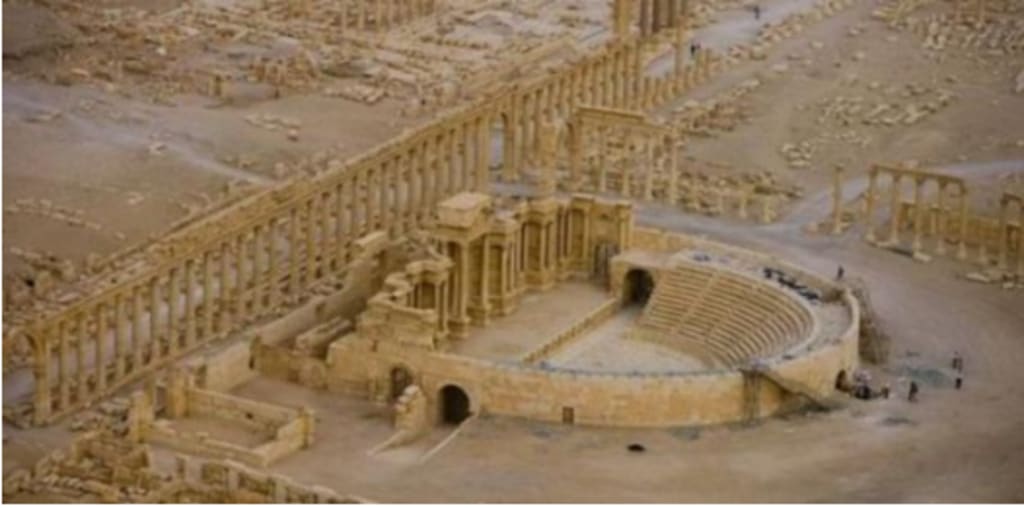Palmyra
A Historic City Rising from the Sands

Located in the heart of Syria, the ancient city of Palmyra, also known as Tadmor, is a mesmerizing archaeological site that dates back thousands of years. Its rich history, breathtaking ruins, and unique cultural significance make it a UNESCO World Heritage site and a must-visit destination for history enthusiasts and travelers alike. Spanning over 6000 years of civilization, Palmyra's allure lies in its remarkable blend of Roman, Greek, and Persian influences.
Palmyra's origins can be traced back to the Neolithic period, around 2000 BCE when it served as a small oasis settlement. However, it wasn't until the 1st century CE that Palmyra began to flourish as a major trading hub, thanks to its strategic location on the ancient Silk Road. The city's prosperity continued to grow under the rule of the Palmyrene Empire, which emerged in the 3rd century CE.
Under the Palmyrene Empire, Palmyra transformed into a thriving cosmopolitan center. Its architecture, characterized by a unique fusion of Roman and Eastern styles, showcased the city's cultural diversity. The grand colonnade, the Temple of Bel, and the monumental Arch of Triumph are some of Palmyra's iconic landmarks that have withstood the test of time.
The city's golden age came to an abrupt end in 273 CE when it was conquered by the Roman Empire. Despite this setback, Palmyra retained its cultural significance and continued to prosper as a regional center. The city's influence extended beyond trade and economy, encompassing art, literature, and religion.
Tragically, Palmyra faced immense destruction and devastation during the Syrian Civil War, which began in 2011. The ancient ruins became a battlefield and fell under the control of different warring factions. The Islamic State of Iraq and Syria (ISIS) particularly targeted the city, vandalizing and destroying numerous structures, including the Temple of Bel and the Arch of Triumph. The loss of Palmyra's cultural heritage was a devastating blow to humanity.
Despite the immense damage, efforts are underway to preserve and restore Palmyra's glory. International organizations, local authorities, and passionate individuals have come together to document the damage, salvage artifacts, and rebuild the damaged structures. The liberation of Palmyra from ISIS in 2016 marked a turning point in the city's recovery, and reconstruction work has been ongoing since then.
Today, Palmyra stands as a symbol of resilience and hope. The painstaking efforts to safeguard its cultural heritage and restore its ancient ruins demonstrate humanity's commitment to preserving our shared history. While the scars of war remain visible, visitors can still marvel at the grandeur of Palmyra's surviving structures and imagine the city's former magnificence.
A visit to Palmyra is not just a journey through time but also an opportunity to pay tribute to the resilience of the Syrian people. It serves as a reminder that even in the face of destruction, our collective efforts can help revive the beauty that once graced this ancient city.
In conclusion, Palmyra's significance transcends its physical ruins. It represents the spirit of humanity's cultural heritage and the determination to preserve it. As the city continues its journey of recovery, it inspires us to cherish and protect the historical treasures that connect us to our past. Palmyra, a city rising from the sands, invites us to explore, learn, and appreciate the rich tapestry of human civilization.
In the heart of Syria's desert, lies the ancient city of Palmyra, a timeless marvel that captivates the imagination. Its ruins, a testament to a bygone era, whisper tales of glory and resilience. As we bid adieu to this enchanting city, let us carry its legacy in our hearts, preserving its memory and honoring the indomitable spirit of those who came before us. Palmyra, a beacon of history and a symbol of endurance, shall forever inspire us to cherish our cultural heritage and safeguard the treasures that connect us to our past.
About the Creator
shahd amer
I love writing about ancient culture and archeology in the world, and this is not just love, but this is also my study, which makes me enjoy getting to know different cultures






Comments
There are no comments for this story
Be the first to respond and start the conversation.